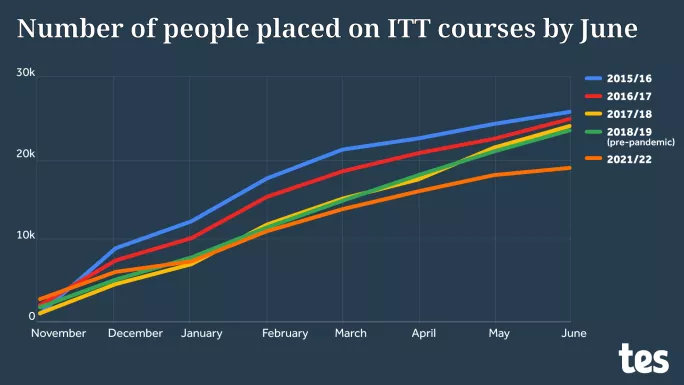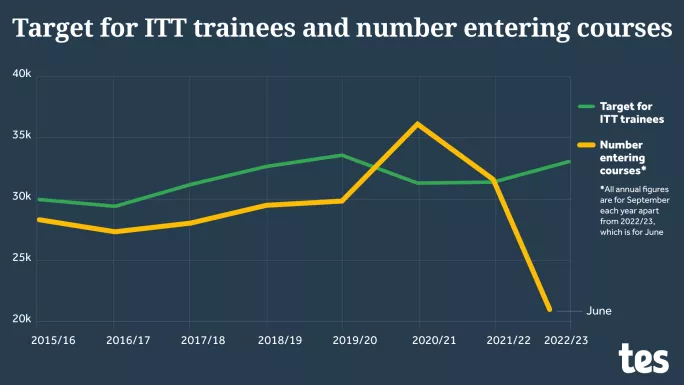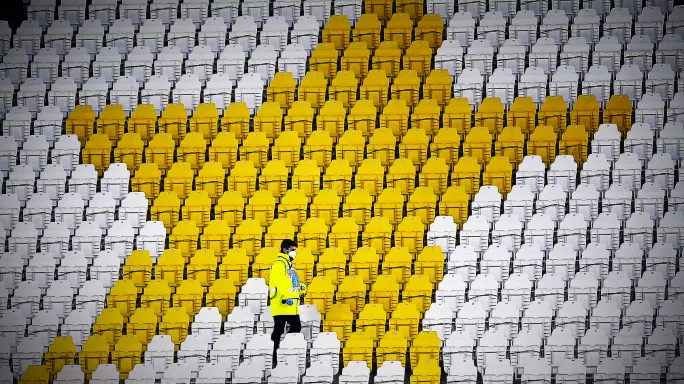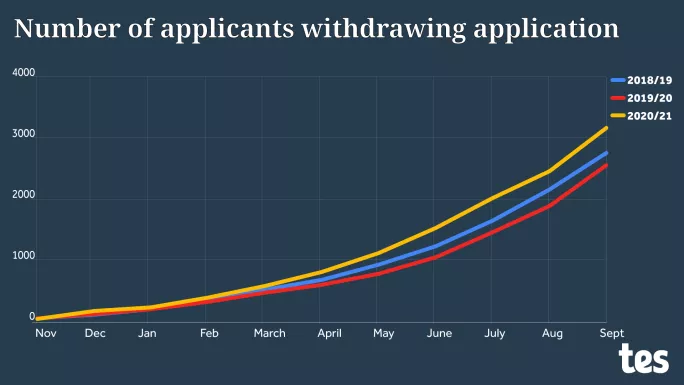Teacher recruitment: Why ‘nothing is going to save us’

Applications to initial teacher training (ITT) courses are plummeting as the wider labour market recovers in the aftermath of the pandemic.
And the warning from experts is stark: we stand zero chance of hitting this year’s recruitment targets for trainees.
But, as we reach the end of this academic year, what exactly does the latest ITT data tell us about the outlook for teacher supply? And how will this affect schools from September, and beyond?
Teacher recruitment: schools face staff shortages
School leaders are already anticipating severe staffing challenges for 2022-23, with some having to plan supply cover now, for September, to fill the inevitable gaps.
“This is the first time ever I’ve come into the penultimate week of term and I’m not fully staffed for September,” says Andy Byers, headteacher at secondary school Framwellgate School Durham.
But the latest official data suggests that leaders will face even greater problems in 2023, with fewer early career teachers available after the fall in ITT applications.
By mid-June of this year, 20,888 ITT trainees had been placed on courses - a figure 13 per cent lower than in the last pre-pandemic year of 2019.

While there has long been a gap between ITT targets and the actual number of trainees, this gap has widened significantly since before the pandemic.
The latest ITT figures come up 36 per cent short of the 32,600-trainee target set last month by the Department for Education.
This compares with a 26 per cent shortfall in June 2019, according to Ucas data.

‘Nothing is going to save us’
Although, in theory, the DfE still has three months left to hit this year’s target, that ship has already sailed, according to Jack Worth, school workforce lead at the National Foundation for Educational Research (NFER).
“Nothing is going to come along this year and save us from missing the recruitment targets,” he says.
Could higher pay make a difference? The teacher starting salary is rising to £30,000 by 2023, and the DfE announced this week that it was upping its 2022-23 pay rise offer to experienced teachers from 3 per cent to 5 per cent.
However, this may not be enough to tempt graduates into the profession, according to Worth.
- Teacher recruitment: Job adverts up 14 per cent compared with before Covid
- Recruitment and retention: What’s going wrong?
- Teacher shortages: Cutting workload and bringing in flexible working could boost recruitment
“Despite being a higher pay award than teaching has seen in decades, [it] did very little to address the underlying loss of competitiveness since 2010,” he says.
Indeed, the decision “is likely to maintain the status quo of high numbers of teachers leaving and under-recruitment across many secondary subjects” and will “not improve the long-term attractiveness of teaching”, he adds.
Pepe Di’Iasio, president of the Association of School and College Leaders and headteacher of Wales High School in Rotherham, says graduates will be looking at their options and might be “more likely” to look to work in the private sector, where pay is “going up to meet that challenge of the cost of living”.
And many school leaders are questioning whether they will be able to budget for the pay rise, which is not fully funded.
The rise comes at a time when schools “are already being hit by massive increases in energy costs over the coming year, and I can really see school budgets going off a cliff edge in many parts of the country because of increased demands”, warns Di’Iasio.
Even the prospect of a £30,000 starting salary for teachers is not expected to have an impact on ITT applications for this September. While applications remain open over the summer for many ITT courses, most are typically submitted by the end of this term.
Worth says he does not expect “any sudden surge that will improve the situation overall” over the summer holidays.
“Recruitment has been more and more challenging every year for the last 10 years”
This all makes gloomy reading for schools hoping to recruit early career teachers (ECTs) in 2023, given that new teachers make up around 5 per cent of the teacher workforce and provide a crucial supply pipeline.
“A steady stream of ECTs into the profession is vital to balance teacher losses from retirements, those leaving for other teaching posts and the current growth in pupil numbers across much of the secondary sector,” says Professor John Howson, long-time commentator on teacher supply and chair of TeachVac.
“ECTs will also become the school leaders of tomorrow and for the longer term into the second half of this century,” he adds.
Of the 43 full-time equivalent (FTE) teachers recruited at Byers’ school in the past four years, at least half were ECTs or Teach First trainees.
Recruitment is the “biggest challenge facing schools at the moment” but it is “going to be worse next September”, he says.
“It’s been more and more challenging every year for the last 10 years,” he says.
While the headline figures are alarming enough, which subjects are facing the biggest teacher shortages?
Biology has seen the sharpest fall in trainees placed on courses since before the pandemic, according to Tes analysis - with the number down by 64 per cent when comparing June 2022 with the same month in 2019.
The number of placed applicants for the subject was 492 as of 20 June 2022. A further 288 would be required to reach the target of 780.

Worth says this fall could be due to bursary changes. For the 2021-2022 academic year, the biology bursary fell from £26,000 to £7,000.
The bursaries for physics and chemistry this year were £24,000.
If 2022 follows previous seasonal trends, the number of biology trainees could be 14 per cent below target by September.
Worth says it is “concerning” that the figures for “all three sciences” are “likely to be way below the combined target” of 4,275.
He added that biologists will be needed to cover physics and chemistry shortages.
Modern foreign languages is also a concern. NFER analysis based on figures from last month reveals that the number of placed applicants was 35 per cent below pre-pandemic levels.
And there are problems with computing, too: the June 2022 recruitment number was 29 per cent below the same month in 2019. Meanwhile, geography (47 per cent below), English (37 per cent below) and religious education (28 per cent below) are struggling as well.
It is important to remember that the target figures do not include trainees from Teach First, which does not release its data until the autumn.
‘Students will get a worse deal’
Clearly, then, the recruitment problems are now much broader than maths, chemistry and physics, where the difficulties have typically been historically.
Byers says that his school “struggles with almost every subject now”, except PE and history.

He says the shortages have “gradually increased to almost every subject” and that, as a result, schools are short of both “quality” and “quantity”, which is having a “huge impact”.
“Gradually, outcomes will worsen…and resources that should be directly put into the students will be diverted to spend on supply and on advertising and recruitment costs…Ultimately, the students will get a worse deal,” says Byers.
While recruitment problems have been building for a decade, experts say that many schools have managed to keep staff shortages “hidden” until now - but that this is set to change.
“Some subject areas for next year look really quite desperate,” says Georgina Newton, associate professor in the Centre for Teacher Education at the University of Warwick.
“There have been shortages for the last 10 years, so a lot of what schools have already done is kind of hidden, but it has been happening…there aren’t many options open to them now.”
She gives the example of a school “grappling” with finding a music teacher. “For a number of years, they’ve used their peripatetic opportunities - they’ve drafted in anybody that they could to help them with this,” she says.

But this approach is becoming increasingly challenging “because of the hollowing out of the skill base”, she says. “And what that results in is the narrowing of the curriculum,” Newton adds.
But Worth says schools are still finding “creative ways” to plug teacher gaps and that, while the effects of staff shortages are likely to be “detrimental”, they will not be obvious.
It is “rarely the case” that a teacher shortage results in “classes sitting without a teacher in front of them”, he says.
The pandemic recruitment boom falls flat
Some may be hoping that the bumper number of ITT applications that we saw during Covid could offset the fall in applications this year. Unfortunately, that is unlikely.
The number entering the system for the 2020-2021 academic year far exceeded the DfE’s target, hitting 35,467 - a rise of 20 per cent on the previous year. But in June, government data showed that retention rates for newly qualified teachers were already starting to fall to pre-pandemic levels.
In fact, the number of applicants who withdrew an application in June 2021 was 1,520 - a 46 per cent increase on the June 2020 figure (1,040).

This indicates that, while teaching was seen as a secure career choice in the depths of the pandemic, applicants may have had second thoughts as other options have opened up elsewhere.
A DfE spokesperson said that the number of teachers in the system “remains high”, with more than 465,000 teachers “working in state-funded schools across the country, which is 24,000 more than in 2010”.
The spokesperson added that the DfE has announced “significant increases” to teachers’ starting salaries from September, with pay rising 8.9 per cent to £28,000 outside London, alongside other substantial increases for more experienced teachers.
“Tax-free bursaries and scholarships worth £24,000 and £26,000 respectively also continue to be available, to encourage talented trainees to key subjects such as chemistry, computing, mathematics and physics,” they said.
The spokesperson added that “500,000 training opportunities” will be delivered by 2024, “giving all teachers and school leaders access to high-quality, evidence-based development at every stage of their career”.
The DfE said it was “putting in place world-class training and development for teachers”, creating a “golden thread” that “runs from initial teacher training (ITT) through to school leadership”.
“Investing in teachers is vital to improving pupil outcomes. We have always said that safeguarding teacher supply is a key priority, and this remains the case,” the spokesperson said.
But with solutions to plug teacher gaps running out for schools, the data suggests that the teacher supply situation is set to get even bleaker - and leaders rightly feel a deep sense of foreboding.
As Di’Iasio puts it: “It’s a storm on its way. We can see it coming and it’s almost like there’s nothing we can do about it at the moment.”
You need a Tes subscription to read this article
Subscribe now to read this article and get other subscriber-only content:
- Unlimited access to all Tes magazine content
- Exclusive subscriber-only stories
- Award-winning email newsletters
Already a subscriber? Log in
You need a subscription to read this article
Subscribe now to read this article and get other subscriber-only content, including:
- Unlimited access to all Tes magazine content
- Exclusive subscriber-only stories
- Award-winning email newsletters
topics in this article



